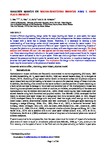AERATION EFFECTS ON WATER-STRUCTURE IMPACTS: PART 1. DROP PLATE IMPACTS
| dc.contributor.author | Tri, M | |
| dc.contributor.author | Mai, C | |
| dc.contributor.author | Raby, Alison | |
| dc.contributor.author | Greaves, Deborah | |
| dc.date.accessioned | 2019-10-22T12:31:57Z | |
| dc.date.issued | 2019-12 | |
| dc.identifier.issn | 0029-8018 | |
| dc.identifier.other | 106600 | |
| dc.identifier.uri | http://hdl.handle.net/10026.1/15017 | |
| dc.description.abstract |
Current offshore engineering design codes for wave loading are based on pure water, but wave impacts often involve aerated flow, either as a result of air entrapment as the wave overturns or due to impact with a wave that is already broken. Therefore, it is necessary to develop a new understanding of how design codes should incorporate water-air mixture for wave impact. This experimental study investigates aeration effects on wave impacts by means of slamming impacts of a square flat plate onto a pure and aerated water surface, with zero degree dead-rise angle. The (low) aeration level between 0% and 1.6% was applied and the drop velocity varied from about 1 m/s to 7 m/s. There was a significant reduction in the peak impact loads (both pressure and force) for impact in aerated water compared to that in pure water. There was also a significant reduction in the first phase of the pressure and force impulse for aerated water. The variation in impulsive loadings is less sensitive than peak loadings for impacts. The implication for design is that maximum instantaneous loads may be conservative in the presence of aerated water. | |
| dc.format.extent | 106600-106600 | |
| dc.language | en | |
| dc.language.iso | en | |
| dc.publisher | Elsevier | |
| dc.subject | Aeration effect | |
| dc.subject | Slamming | |
| dc.subject | Wave impact | |
| dc.subject | Physical model | |
| dc.title | AERATION EFFECTS ON WATER-STRUCTURE IMPACTS: PART 1. DROP PLATE IMPACTS | |
| dc.type | journal-article | |
| dc.type | Journal Article | |
| plymouth.author-url | https://www.webofscience.com/api/gateway?GWVersion=2&SrcApp=PARTNER_APP&SrcAuth=LinksAMR&KeyUT=WOS:000501643400008&DestLinkType=FullRecord&DestApp=ALL_WOS&UsrCustomerID=11bb513d99f797142bcfeffcc58ea008 | |
| plymouth.volume | 193 | |
| plymouth.publication-status | Published | |
| plymouth.journal | Ocean Engineering | |
| dc.identifier.doi | 10.1016/j.oceaneng.2019.106600 | |
| plymouth.organisational-group | /Plymouth | |
| plymouth.organisational-group | /Plymouth/Admin Group - REF | |
| plymouth.organisational-group | /Plymouth/Admin Group - REF/REF Admin Group - FoSE | |
| plymouth.organisational-group | /Plymouth/Faculty of Science and Engineering | |
| plymouth.organisational-group | /Plymouth/Faculty of Science and Engineering/School of Engineering, Computing and Mathematics | |
| plymouth.organisational-group | /Plymouth/PRIMaRE Publications | |
| plymouth.organisational-group | /Plymouth/REF 2021 Researchers by UoA | |
| plymouth.organisational-group | /Plymouth/REF 2021 Researchers by UoA/UoA12 Engineering | |
| plymouth.organisational-group | /Plymouth/Research Groups | |
| plymouth.organisational-group | /Plymouth/Research Groups/Marine Institute | |
| plymouth.organisational-group | /Plymouth/Users by role | |
| plymouth.organisational-group | /Plymouth/Users by role/Academics | |
| plymouth.organisational-group | /Plymouth/Users by role/Researchers in ResearchFish submission | |
| dcterms.dateAccepted | 2019-05-20 | |
| dc.rights.embargodate | 2019-12-19 | |
| dc.rights.embargoperiod | Not known | |
| rioxxterms.funder | EPSRC | |
| rioxxterms.identifier.project | FROTH: Fundamentals and Reliability of Offshore Structure Hydrodynamics | |
| rioxxterms.versionofrecord | 10.1016/j.oceaneng.2019.106600 | |
| rioxxterms.licenseref.uri | http://www.rioxx.net/licenses/all-rights-reserved | |
| rioxxterms.type | Journal Article/Review | |
| plymouth.funder | FROTH: Fundamentals and Reliability of Offshore Structure Hydrodynamics::EPSRC | |
| plymouth.funder | FROTH: Fundamentals and Reliability of Offshore Structure Hydrodynamics::EPSRC |


